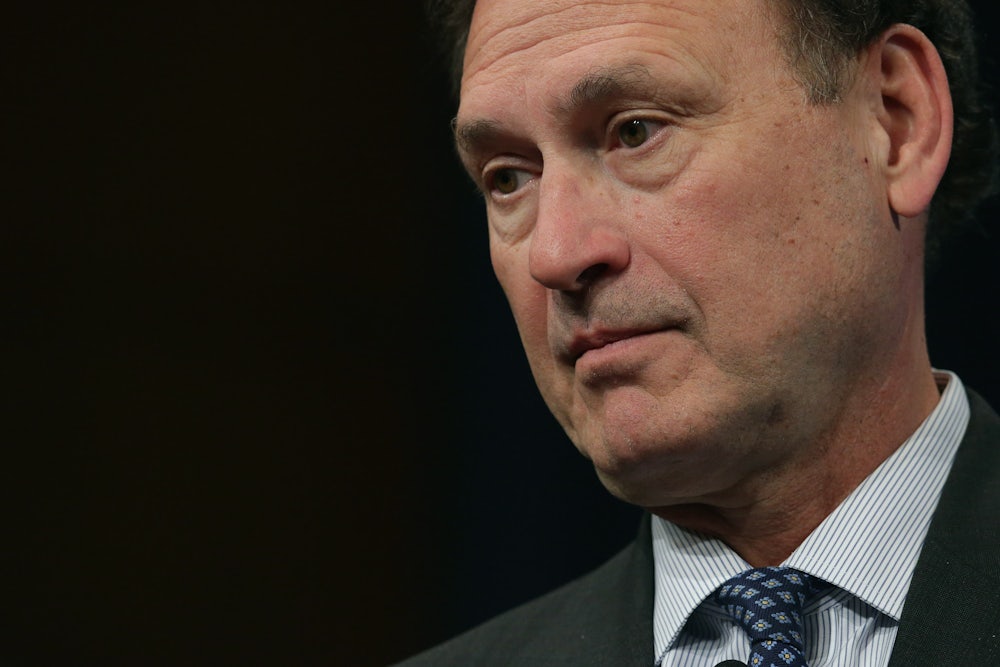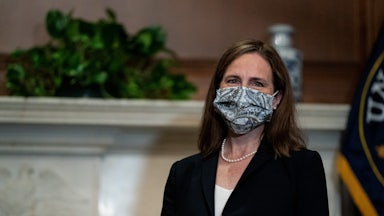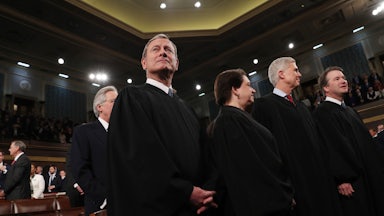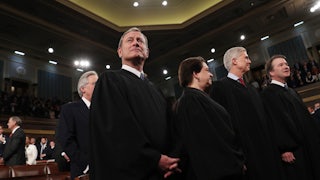The Supreme Court narrowed Americans’ ability to fight racial discrimination in election laws on Thursday, upholding two Arizona measures that had been challenged under a key provision in the Voting Rights Act of 1965. In a 6–3 ruling along the traditional lines, the court’s conservative majority gave states more flexibility to craft their voting laws and practices without violating the landmark statute. The result is good news for Republican state lawmakers who are scrambling to erect new barriers to voting and bad news for voters in those states who now have fewer tools to overcome them.
“Section 2 of the Voting Rights Act provides vital protection against discriminatory voting rules, and no one suggests that discrimination in voting has been extirpated or that the threat has been eliminated,” Justice Samuel Alito wrote for the court. “But Section 2 does not deprive the states of their authority to establish non-discriminatory voting rules,” he explained, rejecting what he saw as a “radical interpretation” of the law from others.
Justice Elena Kagan sharply criticized the majority for once again weakening the Voting Rights Act’s protections. “Today, the court undermines Section 2 and the right it provides. The majority fears that the statute Congress wrote is too ‘radical’—that it will invalidate too many state voting laws,” she wrote in a dissent joined by Justices Stephen Breyer and Sonia Sotomayor. “So the majority writes its own set of rules, limiting Section 2 from multiple directions. Wherever it can, the majority gives a cramped reading to broad language. And then it uses that reading to uphold two election laws from Arizona that discriminate against minority voters.”
“I could say—and will in the following pages—that this is not how the court is supposed to interpret and apply statutes,” Kagan continued. “But that ordinary critique woefully undersells the problem. What is tragic here is that the court has (yet again) rewritten—in order to weaken—a statute that stands as a monument to America’s greatness, and protects against its basest impulses.”
Thursday’s decision came in two cases that had been consolidated by the court for oral argument earlier this spring, Brnovich v. Democratic National Committee and Arizona Republican Party v. Democratic National Committee. At issue were two provisions in Arizona’s election rules: a statewide policy that threw out otherwise lawful ballots if they were cast in the wrong precinct and a 2016 statute that banned most third-party groups from collecting and submitting ballots on voters’ behalf.
The Democratic National Committee sued the state of Arizona over both provisions in 2016, invoking Section 2 of the VRA. Section 2 bans voting practices and procedures throughout the country if they are found to discriminate on the basis of race, ethnicity, or language. The DNC’s lawyers argued that Arizona had a history of rejecting unusually high numbers of out-of-precinct ballots, which they claimed had disproportionately affected a small number of minority voters. They also alleged that the ban on ballot collection, also known as “ballot harvesting,” would reduce participation in rural Latino and Native American communities throughout the state.
Both a federal district court and a three-judge panel in the Ninth Circuit Court of Appeals disagreed with the DNC’s allegations and ruled in favor of Arizona. Those decisions were overturned by an even larger panel on the Ninth Circuit in January 2020. The super-panel used a two-part “results test” to weigh the claims under Section 2. First, does the law or policy in question impose a disparate burden on minority voters’ ability to participate in an election? Second, is there “a legally significant relationship between the disparate burden on minority voters and the social and historical conditions affecting them?” For the Arizona provisions in question, the Ninth Circuit answered yes to both questions.
Arizona Attorney General Mark Brnovich, a Republican who represented the state at the Supreme Court, disputed the DNC’s evidence of racial discrimination and urged the court to rewrite the Ninth Circuit’s test for Section 2 claims. He argued that the state enacted both rules to reduce the risk of voter misconduct and election fraud, a perennial conservative defense of more restrictive election laws. “Public servants have no more sacred duty than protecting the people’s right to vote while maintaining confidence in the integrity of election results,” Brnovich told the justices during oral arguments in March, asking that they outline “a clear and constitutional test that allows states to meet these imperatives.”
In his opinion for the court, Alito declined to provide such a test. Instead, he concluded that it was “sufficient for present purposes to identify certain guideposts that lead us to our decision in these cases.” One of them was the “size of the burden imposed” by a challenged provision, with Alito noting that “mere inconvenience” was not enough to violate Section 2, as well as the “size of any disparities” that came with it. He also concluded that “the degree to which a voting rule departs from what was standard practice” when Section 2’s current form was written in 1982 is a “relevant consideration.”
Some guideposts are more ominous than others. Alito wrote that courts “must consider the opportunities provided by a state’s entire system of voting” when assessing Section 2 challenges. “Where a State provides multiple ways to vote,” Alito concludes, “any burden imposed on voters who choose one of the available options cannot be evaluated without also taking into account the other available means.” That statement suggests that states have greater leeway to limit things like early voting and absentee voting because they are not the only way that a voter could cast a ballot.
He also offered what could be an escape hatch of sorts for many of the voting restrictions under consideration in GOP-led states. His final guidepost was “the strength of state interests” that a challenged voting rule is designed to serve. “Rules that are supported by strong state interests are less likely to violate Section 2,” Alito declared.
So what counts as a “strong state interest?” He only identified one: preventing voter fraud. “Fraud can affect the outcome of a close election, and fraudulent votes dilute the right of citizens to cast ballots that carry appropriate weight,” he wrote. “Fraud can also undermine public confidence in the fairness of elections and the perceived legitimacy of the announced outcome.”
Taken together, Alito’s guideposts read less like a way to interpret the Voting Rights Act and more like a way to circumvent it. The result is hard to distinguish from a blank check for Republican state lawmakers: So long as they invoke voter fraud and don’t say anything too egregious, the Supreme Court will have their back.
Kagan drew the same conclusion, citing the wave of new voting restrictions working their way through state legislatures this year. “Those laws shorten the time polls are open, both on Election Day and before,” she noted. “They impose new prerequisites to voting by mail, and shorten the windows to apply for and return mail ballots. They make it harder to register to vote, and easier to purge voters from the rolls. Two laws even ban handing out food or water to voters standing in line. Some of those restrictions may be lawful under the Voting Rights Act. But chances are that some have the kind of impact the Act was designed to prevent—that they make the political process less open to minority voters than to others.”
The court’s conservative justices had already signaled their willingness to carve a voter-fraud exception into Section 2 during oral arguments. At one point, a lawyer representing Katie Hobbs, Arizona’s Democratic Secretary of State, noted that no such fraud had been found in the state’s elections to justify the provisions in question. Justice Neil Gorsuch was unpersuaded. “Does Arizona have to wait for fraud to occur in Arizona before it can outlaw it?” he asked her. Other justices invoked a report by the Carter-Baker Commission in 2005 to support the concerns. Though the report was intended to bolster Americans’ confidence in the democratic process, it has since become a favored tool of conservative activists to invoke the potential dangers of voting fraud.
“[The commission] said that absentee ballots are the largest source of potential voter fraud,” Chief Justice John Roberts said in a question for Jessica Amunson, the lawyer who represented Hobbs. “They said citizens who vote at home, at nursing homes, at the workplace or church are more susceptible to pressure or to intimidation and that they recommended that the practice of allowing candidates or party workers to pick up and deliver absentee ballots should be eliminated. You disagree with that in this case, right, given your position on ballot harvesting?”
Indeed, some of the conservative justices also appeared disinterested in the potentially harmful effects of the new laws. “I think what concerns me is that your position is going to make every voting rule vulnerable to attack under Section 2 to the same extent that the out-of-precinct policy was found to violate Section 2 by the Ninth Circuit,” Alito told Bruce Spiva, who represented the Democratic National Committee, “because people who are poor and less well-educated on balance probably will find it more difficult to comply with just about every voting rule than do people who are more affluent and have had the benefit of more education.”
In his opinion for the court, Alito transmogrified his assertion at oral arguments into binding Supreme Court precedent. “To the extent that minority and non-minority groups differ with respect to employment, wealth, and education, even neutral regulations, no matter how crafted, may well result in some predictable disparities in rates of voting and noncompliance with voting rules,” he explained when describing his guideposts for future Section 2 claims.
This narrow vision of voting-rights protections drew a strong rebuke from Kagan. “Congress, recall, was intent on eradicating the ‘subtle, as well as the obvious,’ ways of suppressing minority voting,” she wrote. “One of those more subtle ways is to impose ‘inconveniences,’ especially a collection of them, differentially affecting members of one race. The certain result—because every inconvenience makes voting both somewhat more difficult and somewhat less likely—will be to deter minority votes. In countenancing such an election system, the majority departs from Congress’s vision, set down in text, of ensuring equal voting opportunity. It chooses equality-lite.”
The Supreme Court’s hostility towards robust voting-rights enforcement is as tragic as it is unsurprising. In the 2013 case Shelby County v. Holder, the court’s conservative majority gutted Section 5 of the Voting Rights Act, which had required certain state and local jurisdictions with a history of racial discrimination in elections to get federal approval before changing their voting laws. The 5–4 decision by Chief Justice John Roberts helped ignite a wave of new voting restrictions in Republican-led states, accelerating the GOP’s retreat from democratic principles in the years before Trump solidified the authoritarian turn.
In her dissent, Kagan thundered against the majority for once again gutting one of the most important statutes in American history. “But as this Court recognized about a decade ago, ‘racial discrimination and racially polarized voting are not ancient history,’” Kagan wrote, quoting from a 2009 ruling. “Indeed, the problem of voting discrimination has become worse since that time—in part because of what this Court did in Shelby County. Weaken the Voting Rights Act, and predictable consequences follow: yet a further generation of voter suppression laws.”
Voting-rights advocates, for their part, have increasingly few pathways to defend voting rights. Congressional Democrats are currently weighing two major bills to shore up America’s democratic systems: the For the People Act, a package of election-related reforms that passed the House earlier this year, and the John Lewis Voting Rights Advancement Act, which would restore Section 5’s preclearance regime and impose it on every state in the Union. Both bills currently appear doomed in the Senate, however, where an insufficient number of Democrats favor abolishing the filibuster for the sake of protecting voting rights. Without legislative action, voters who face discriminatory burdens on their right to freely cast a ballot must instead call upon a judiciary that is increasingly hostile to their claims.








